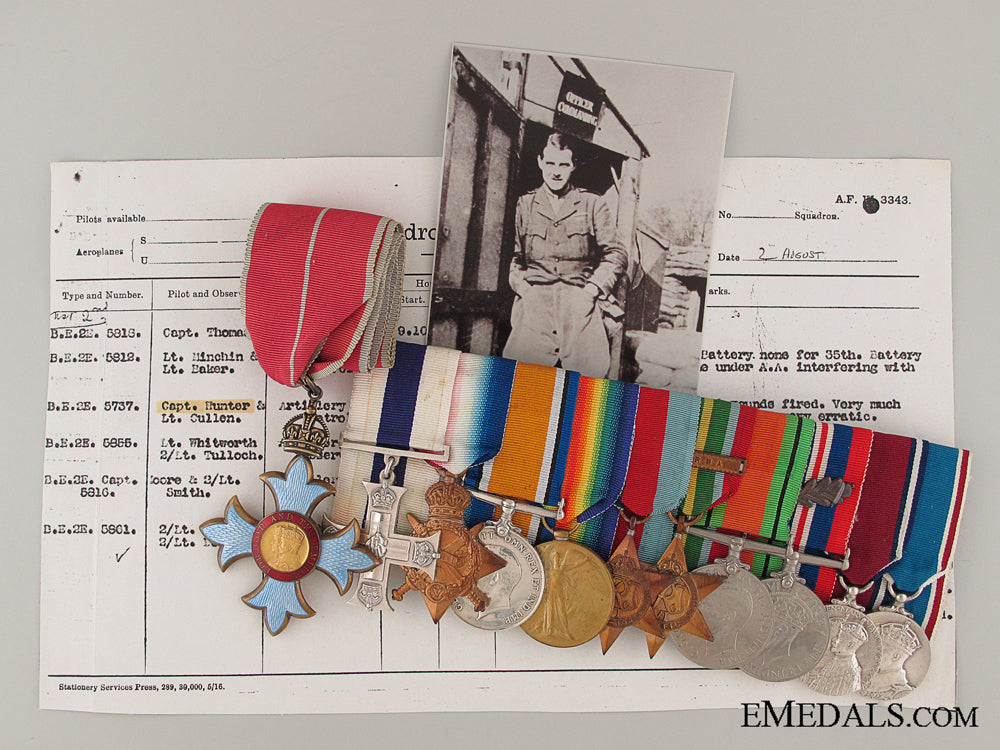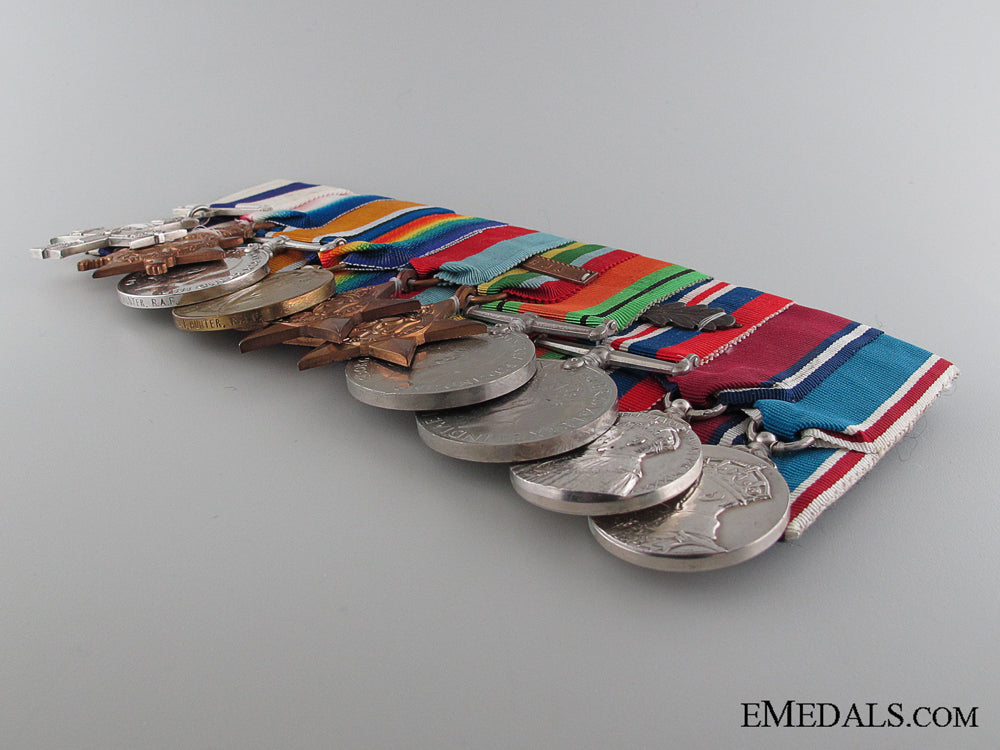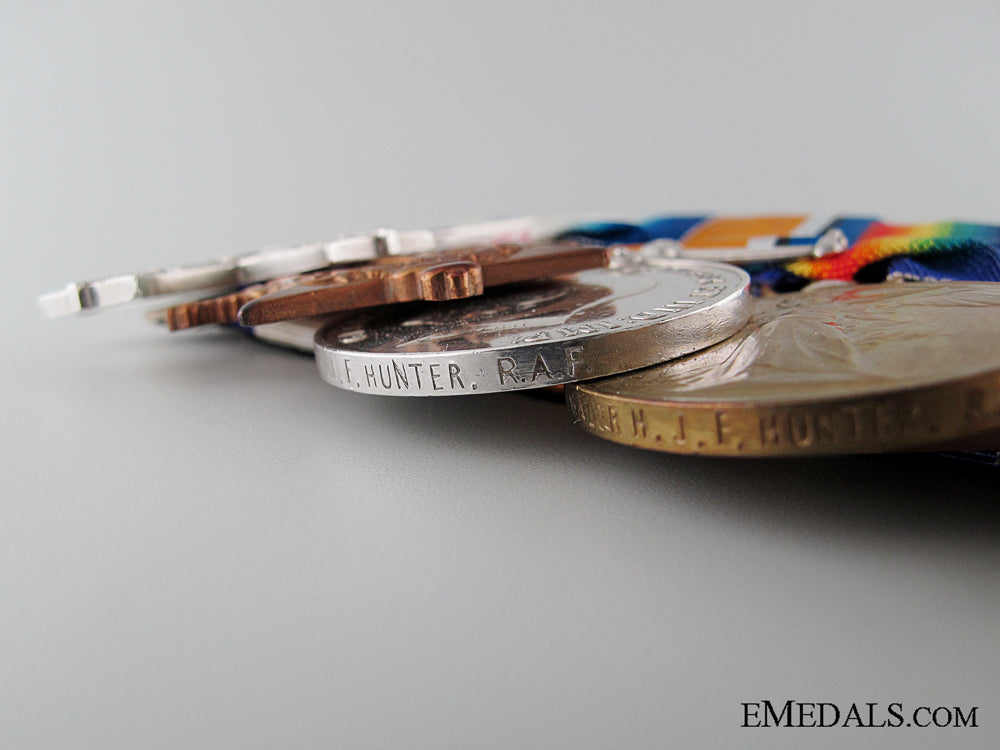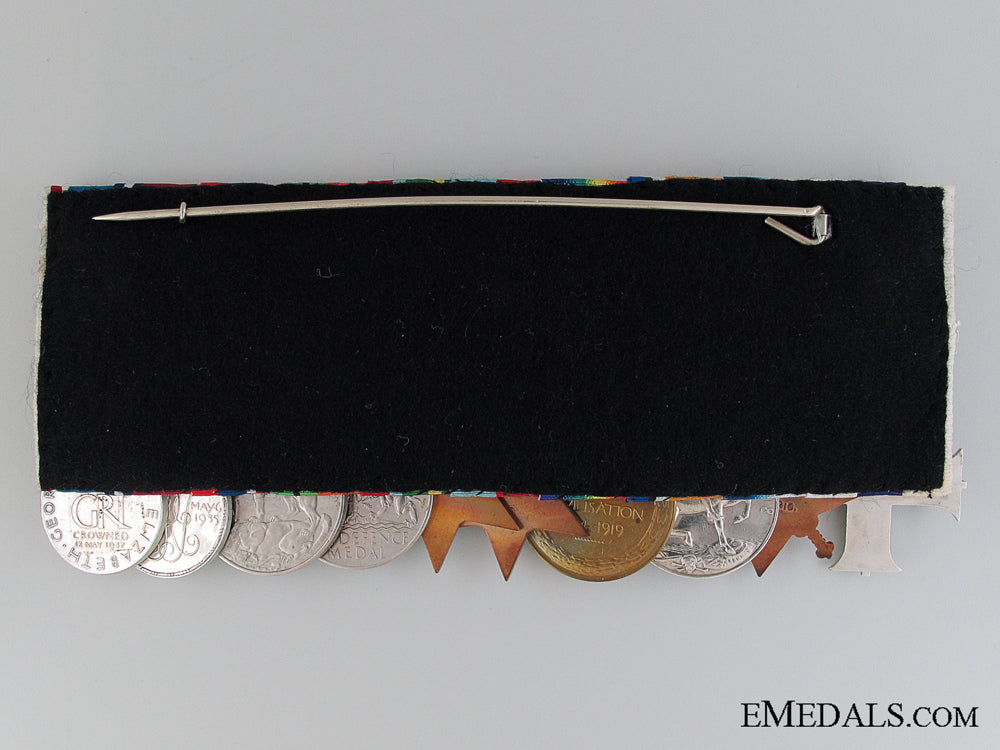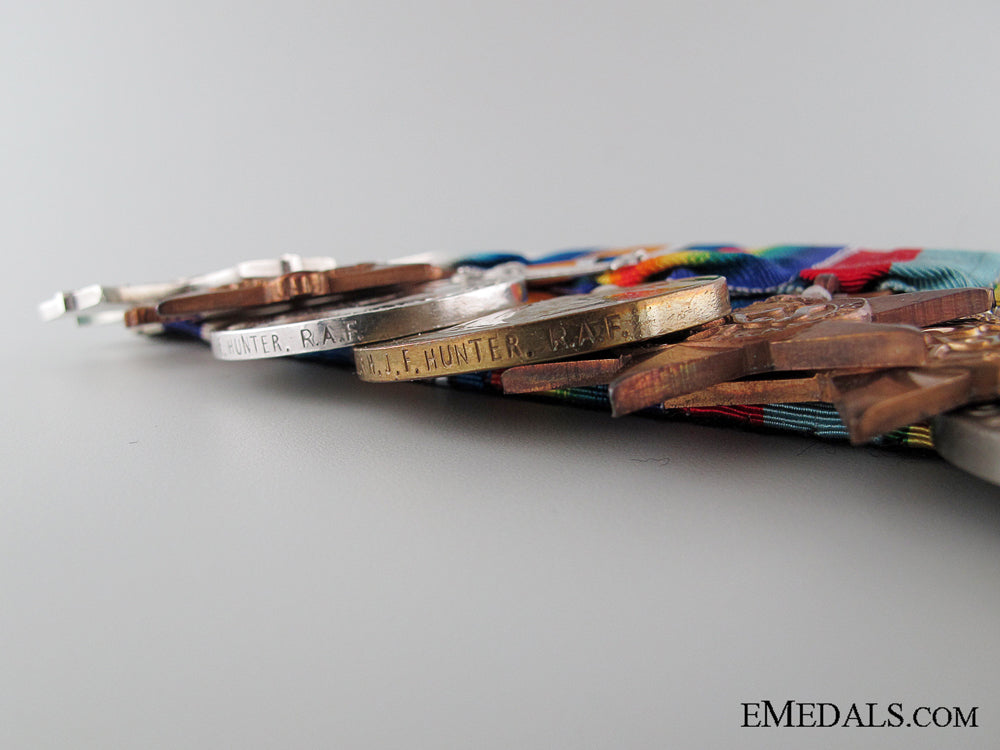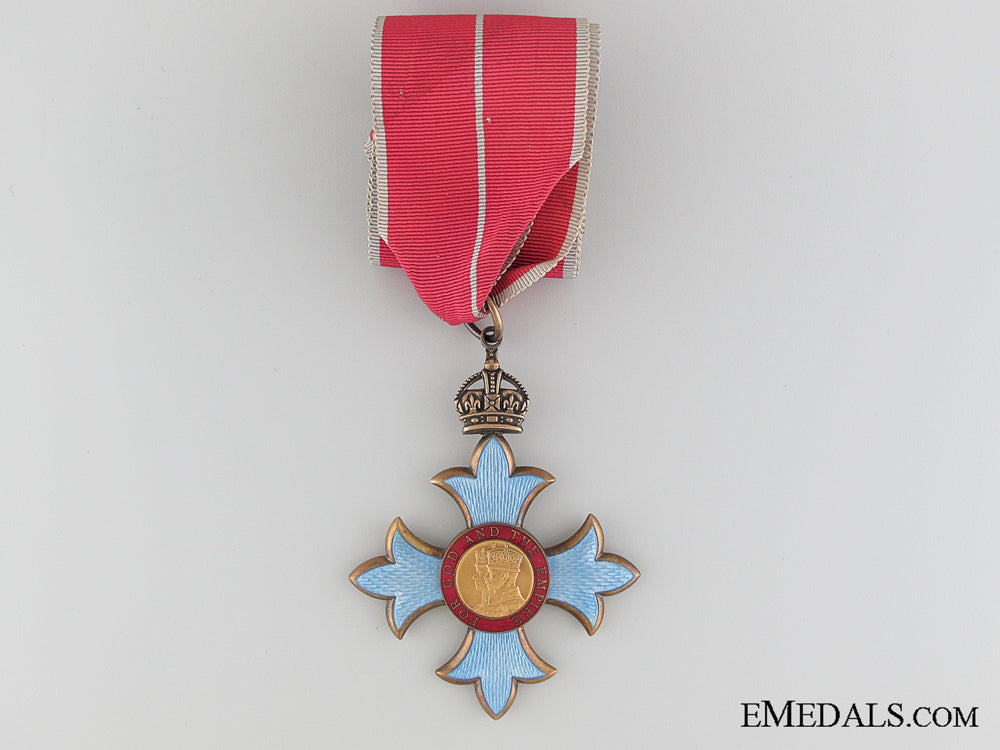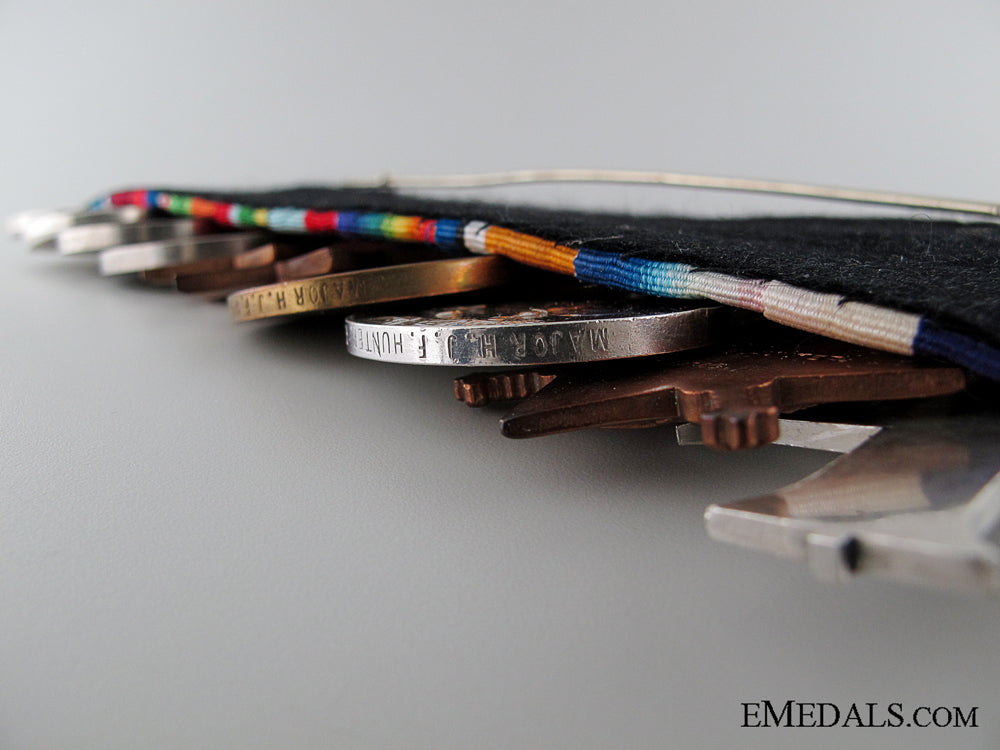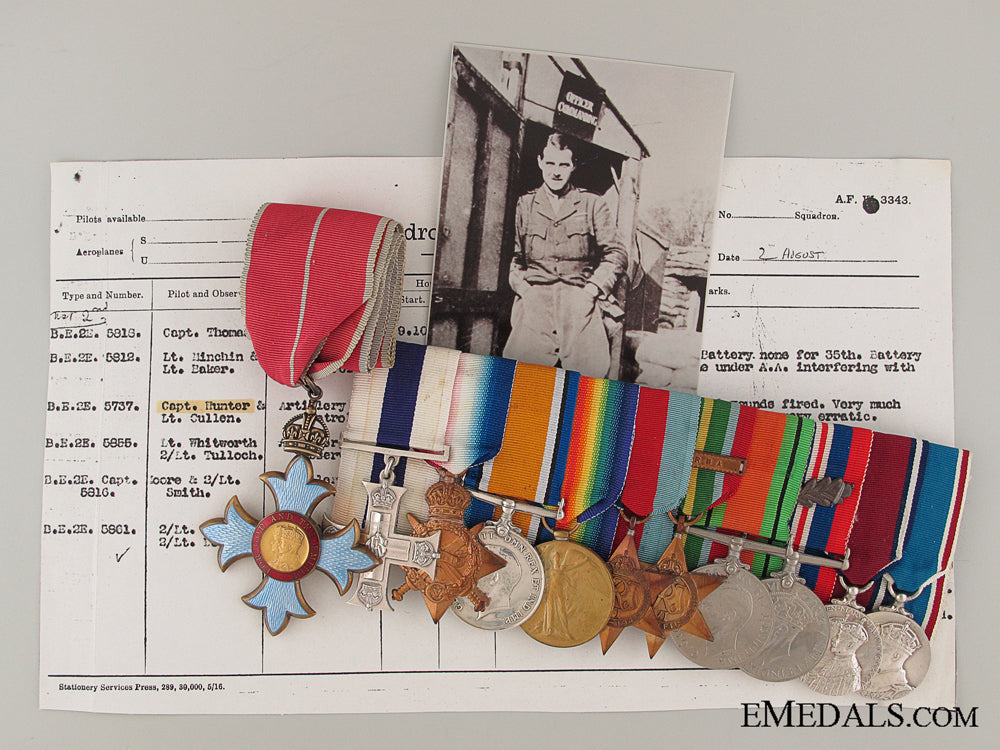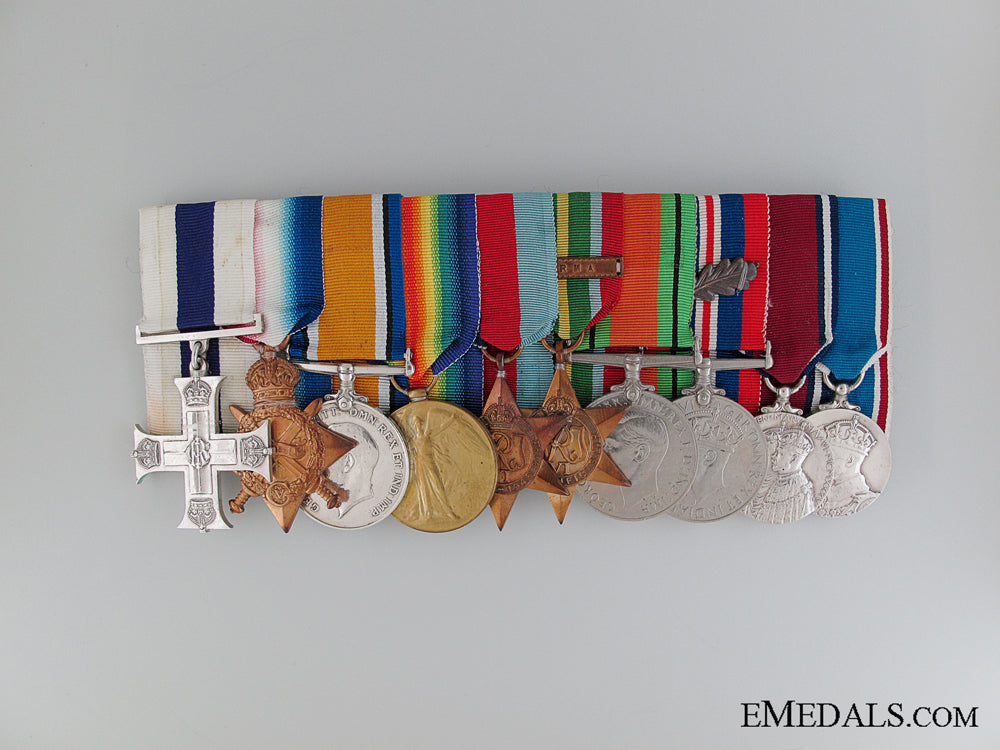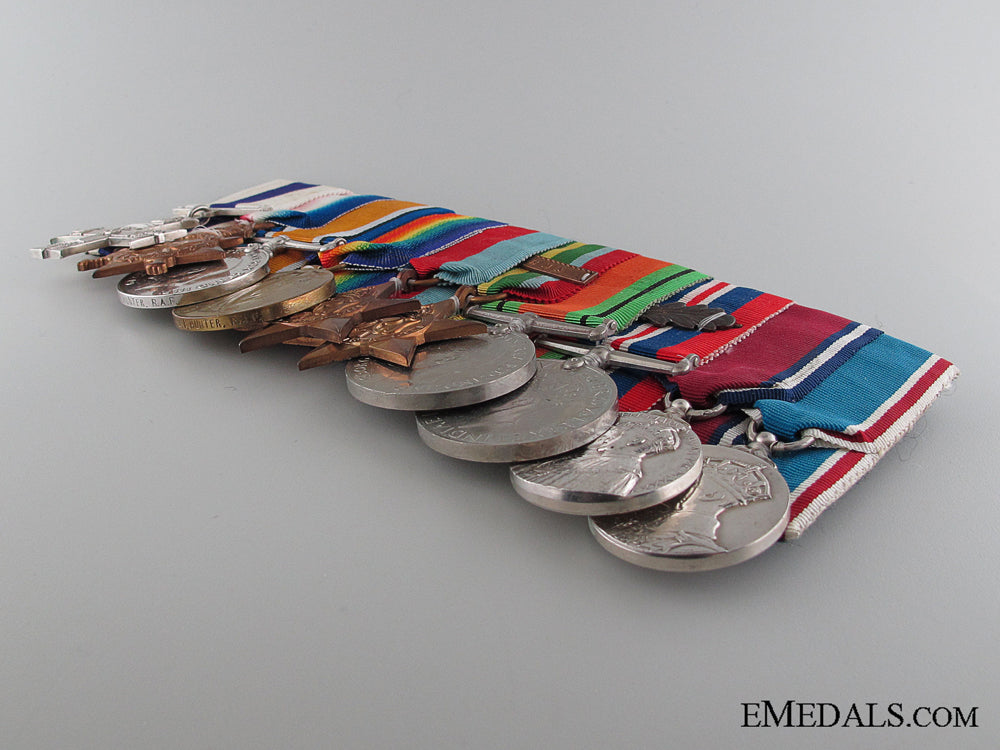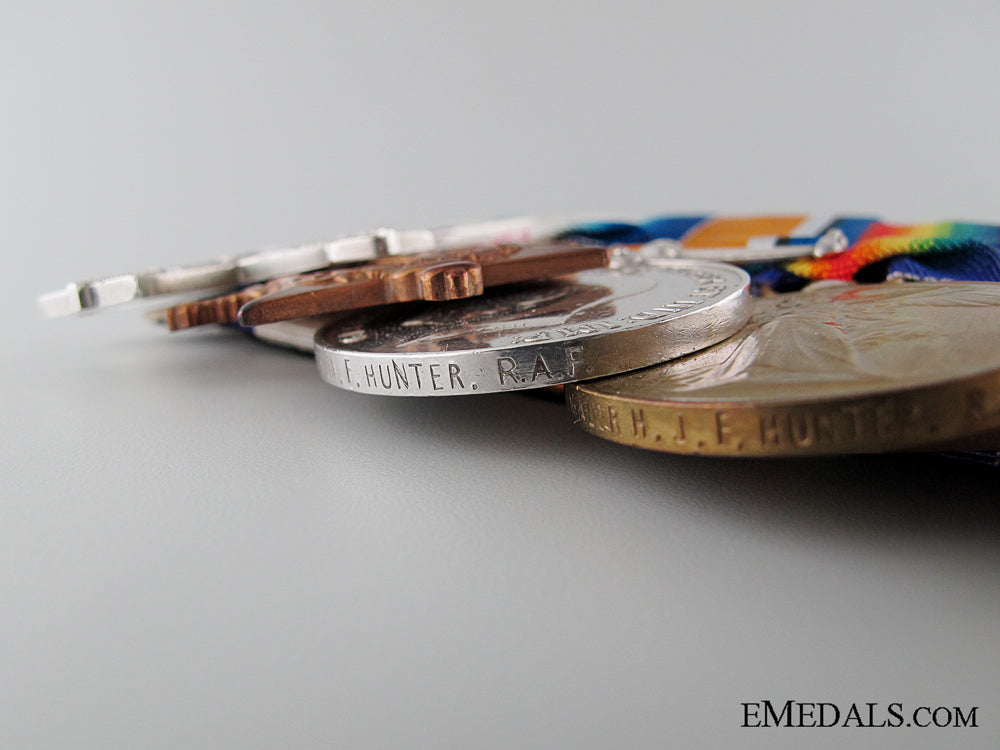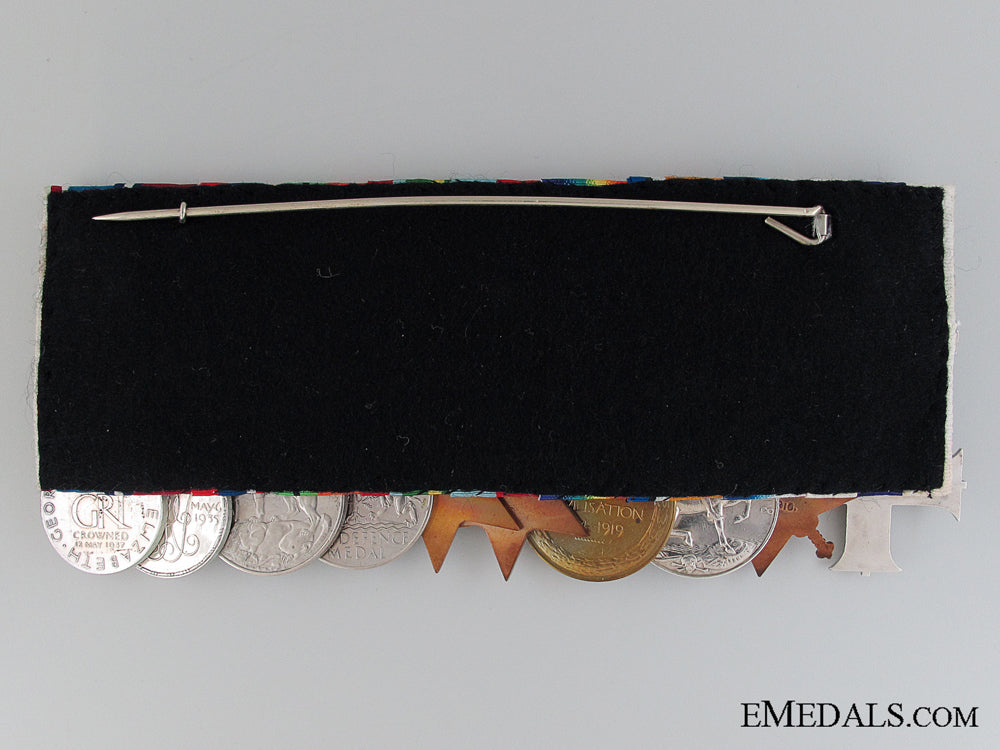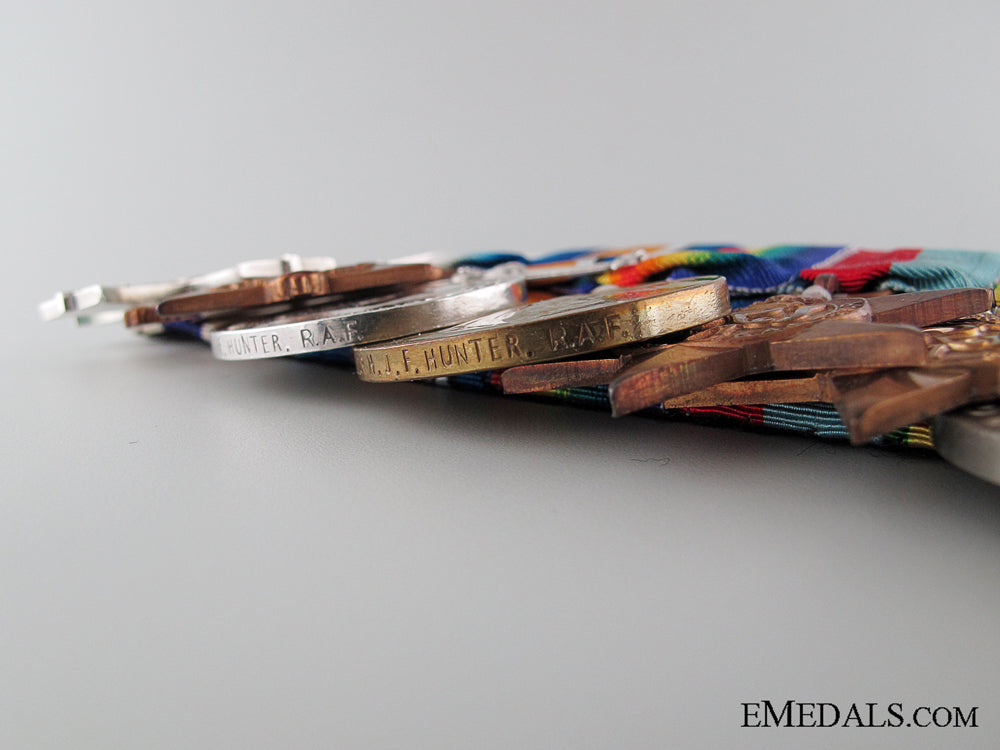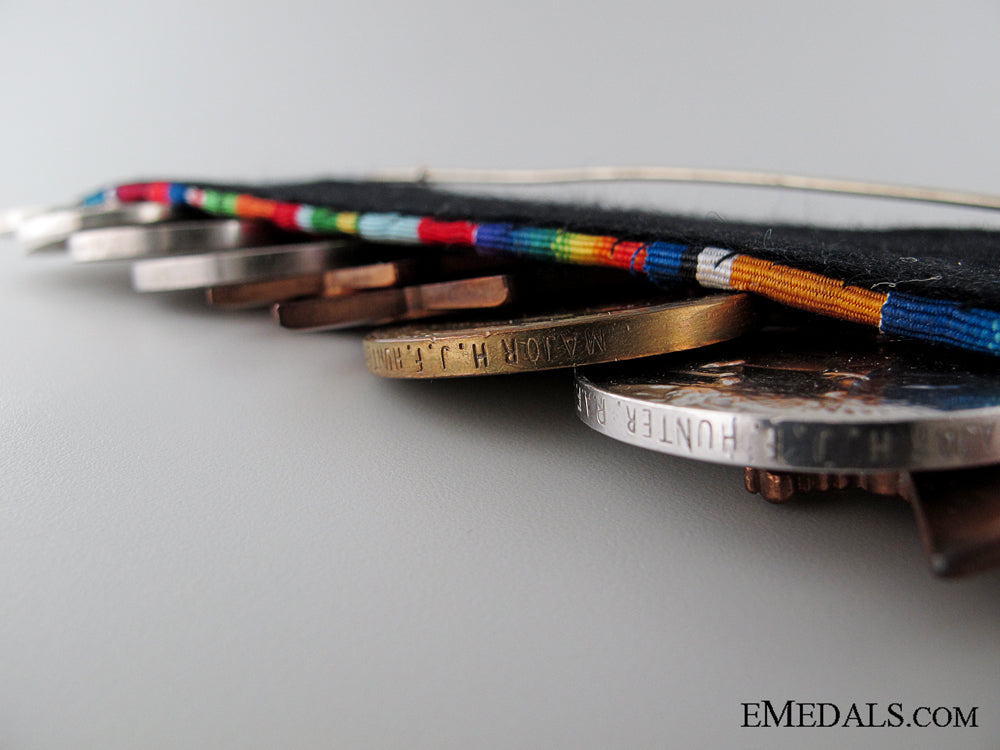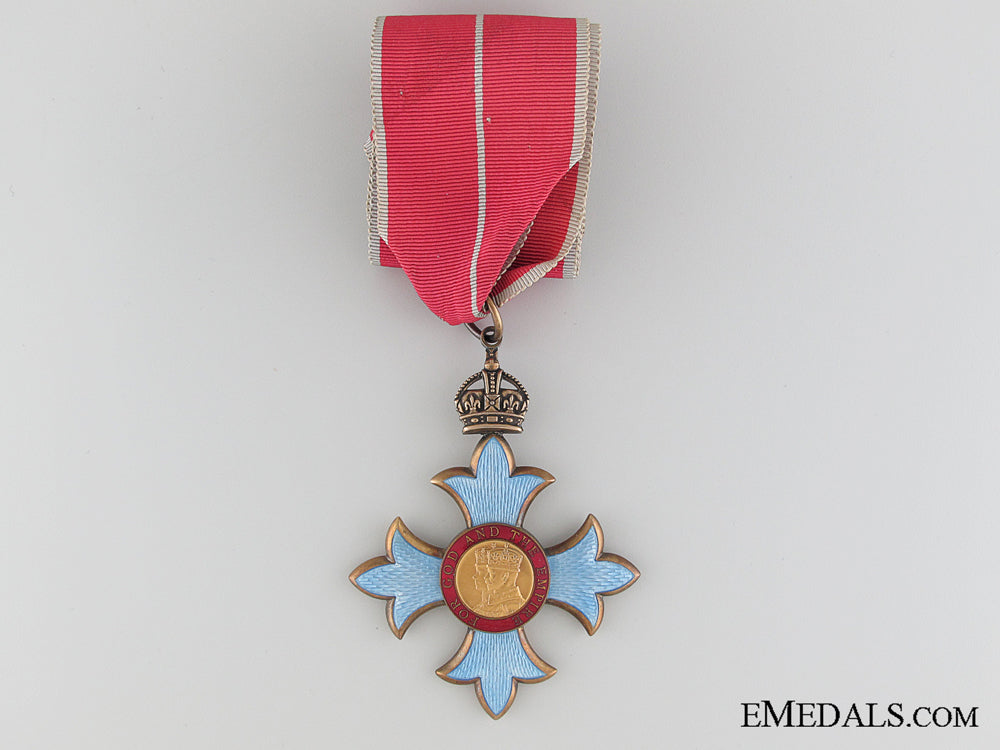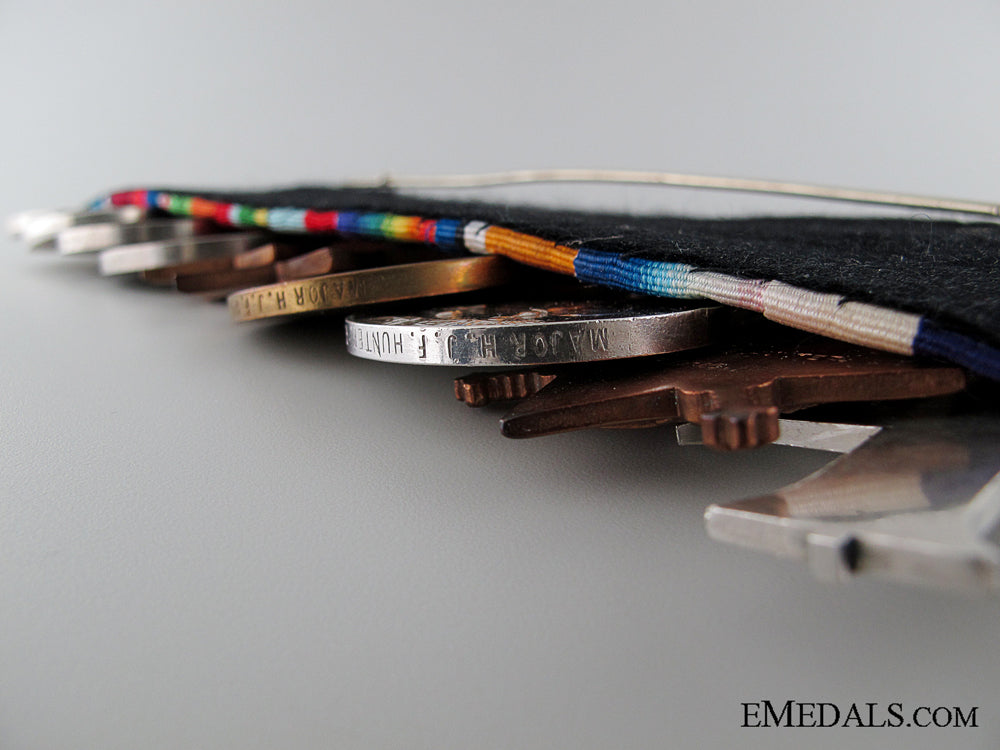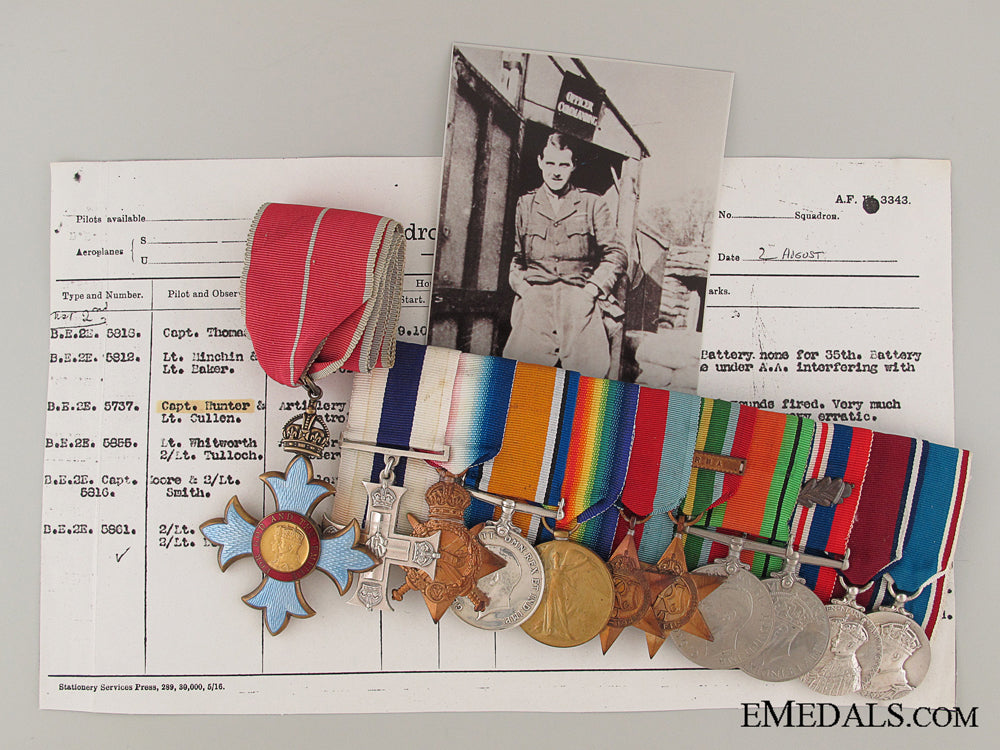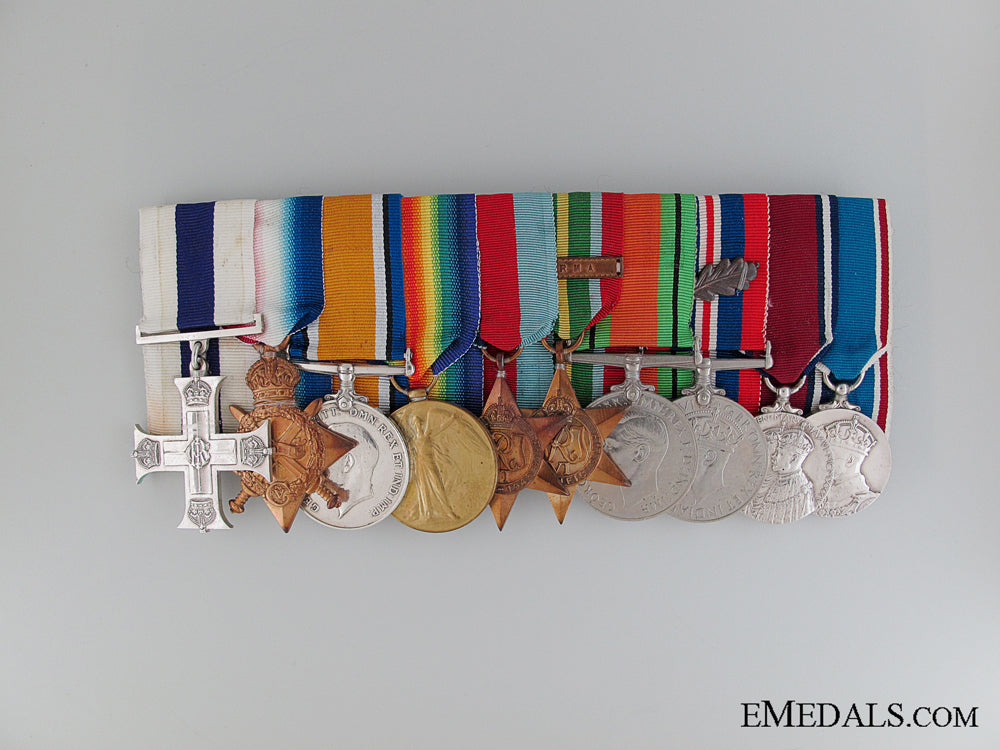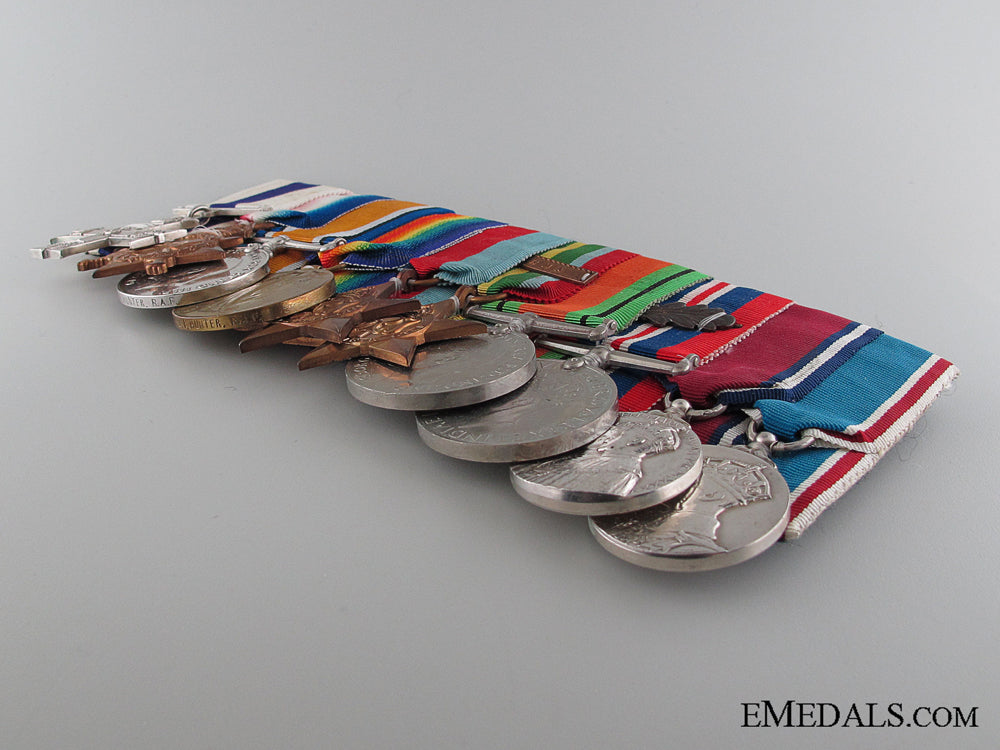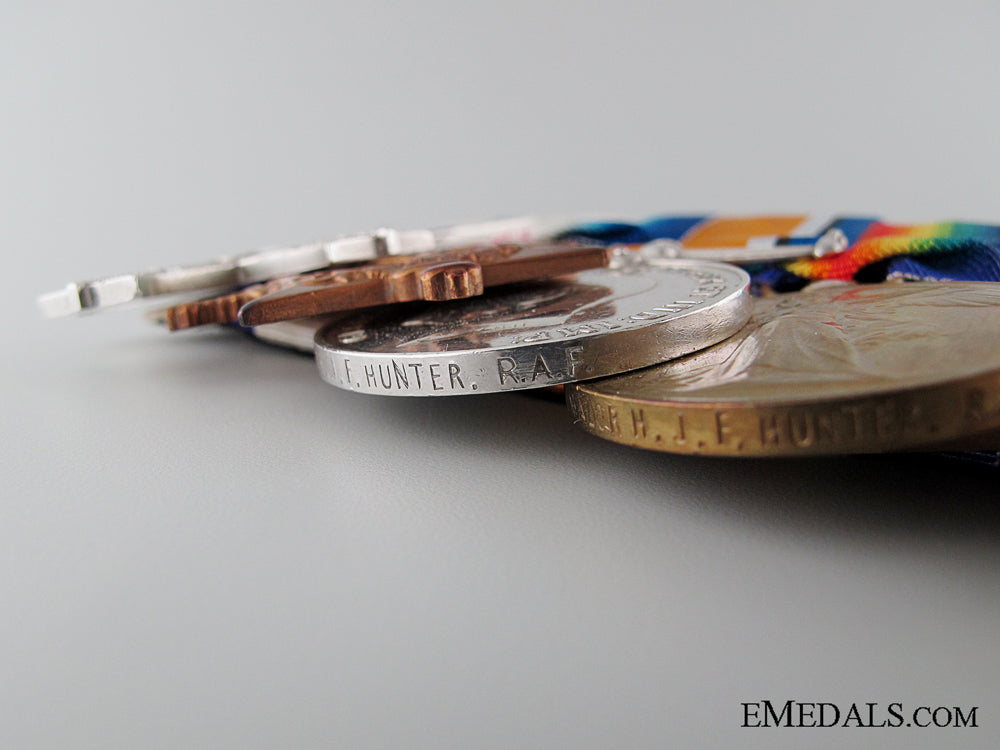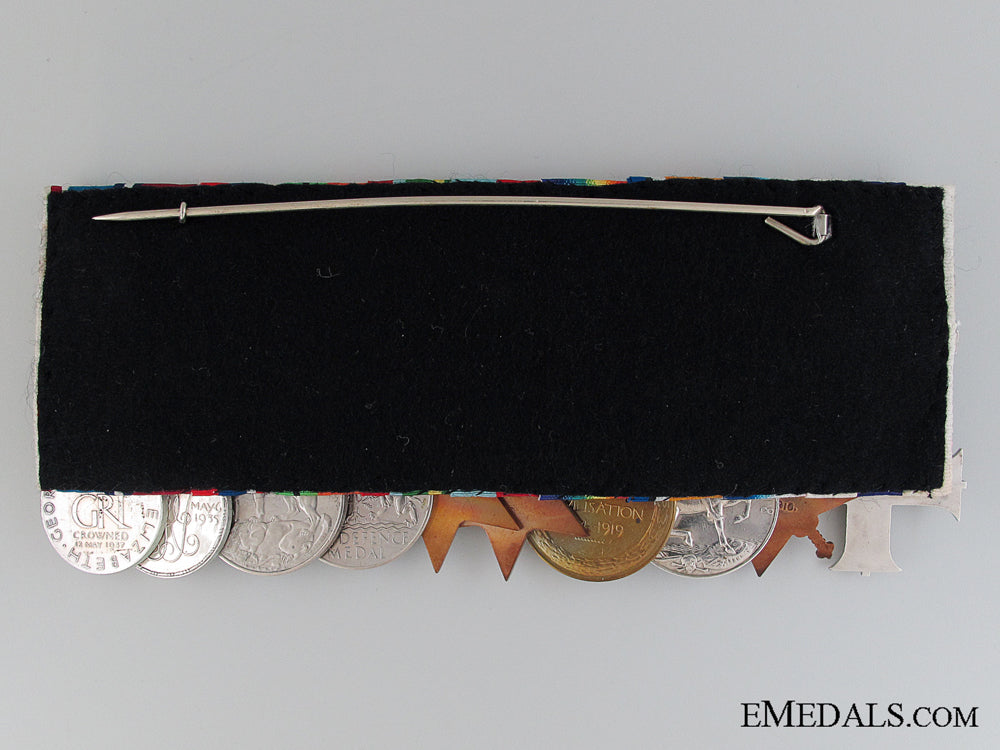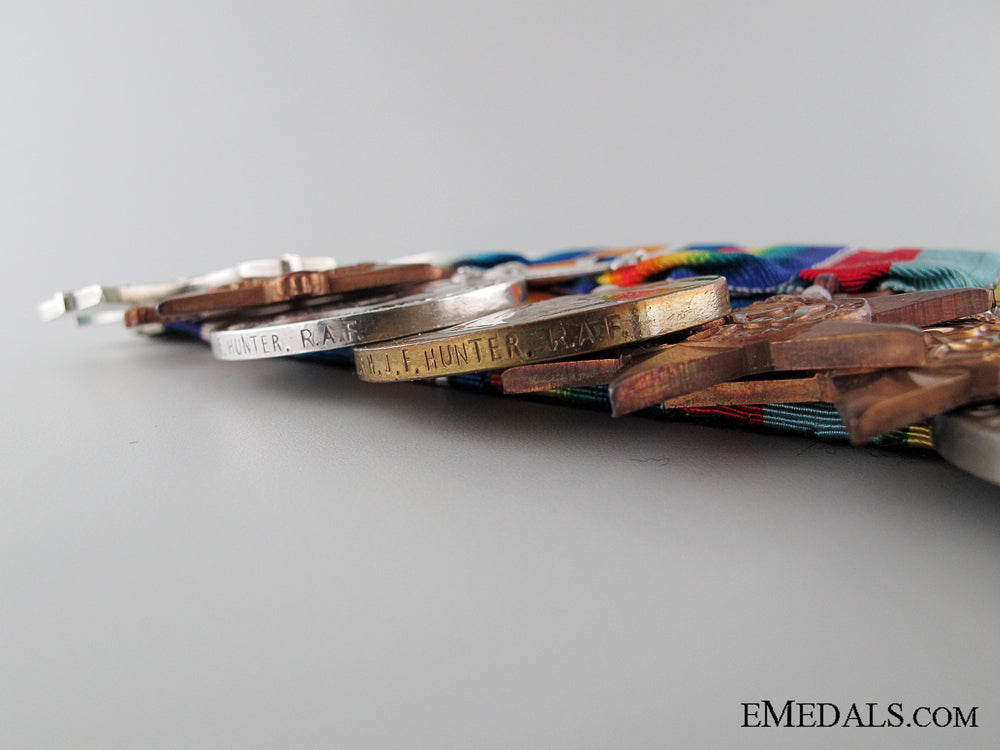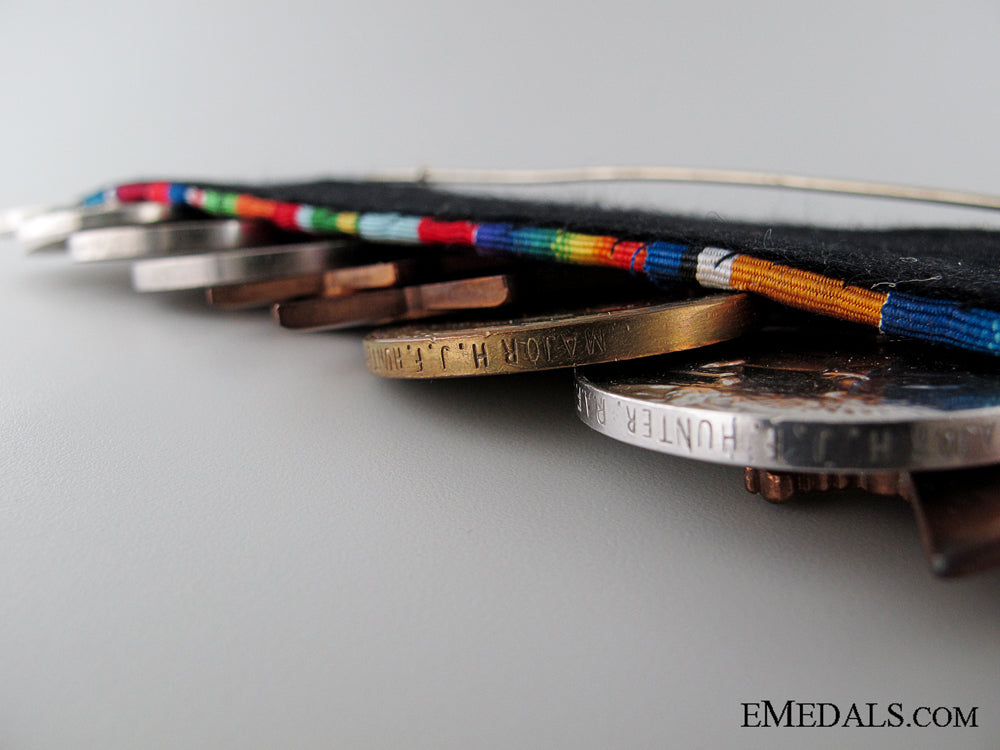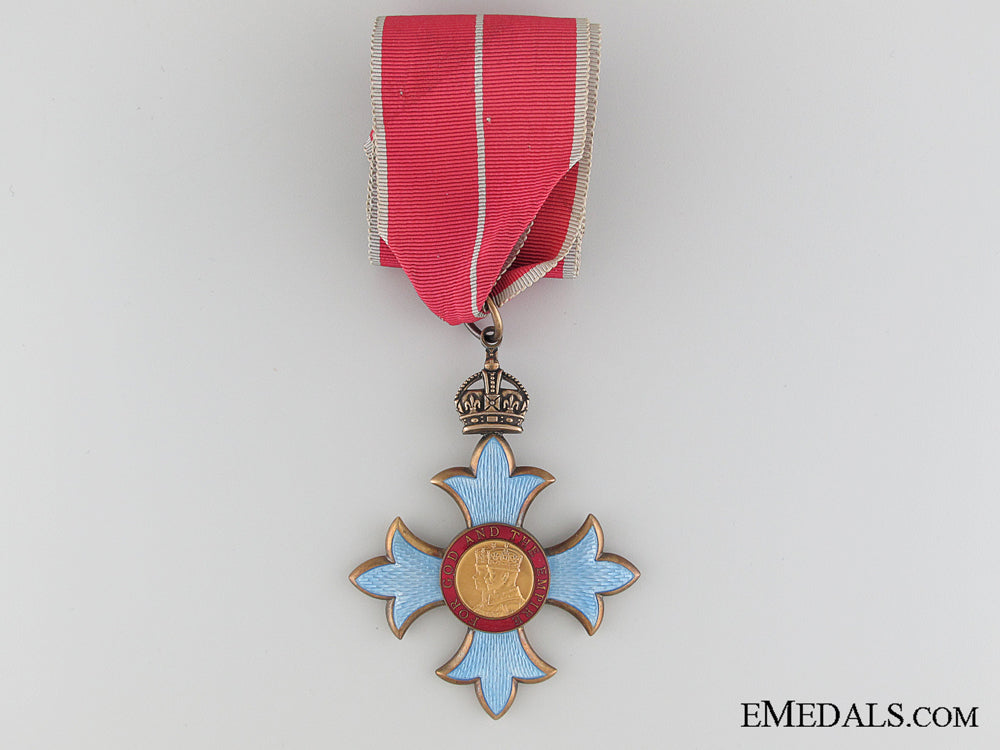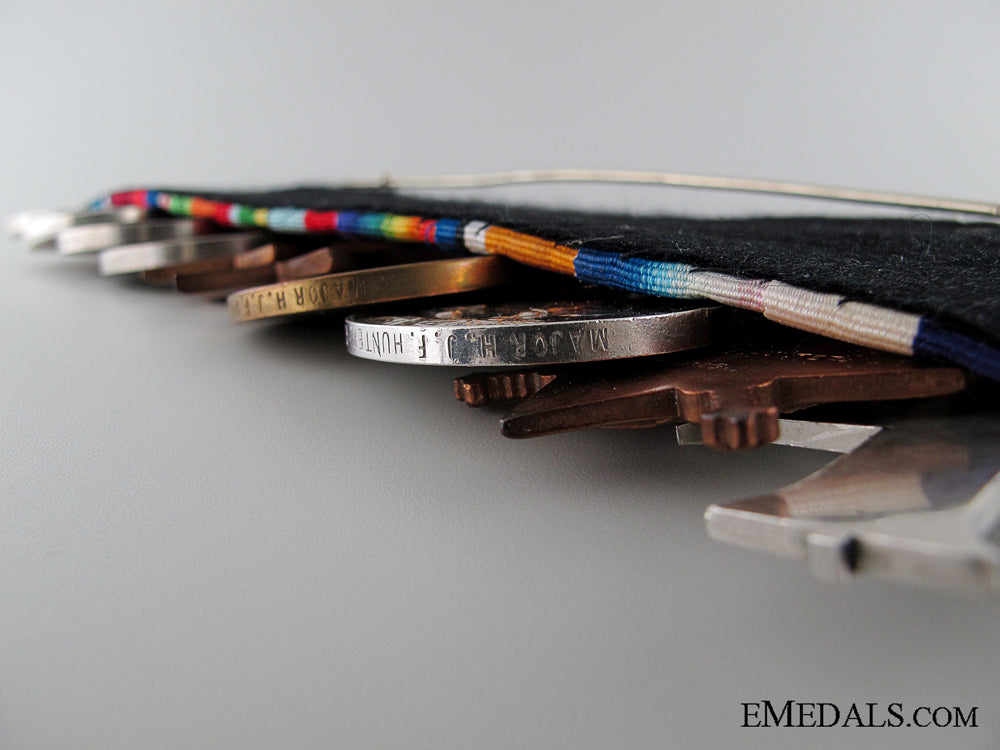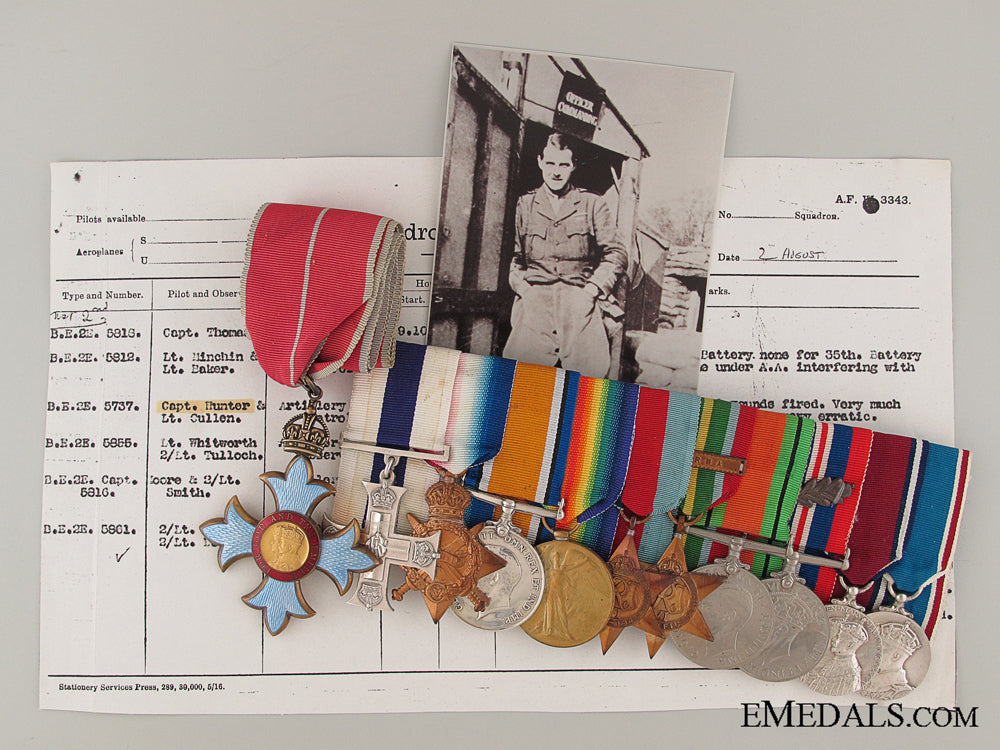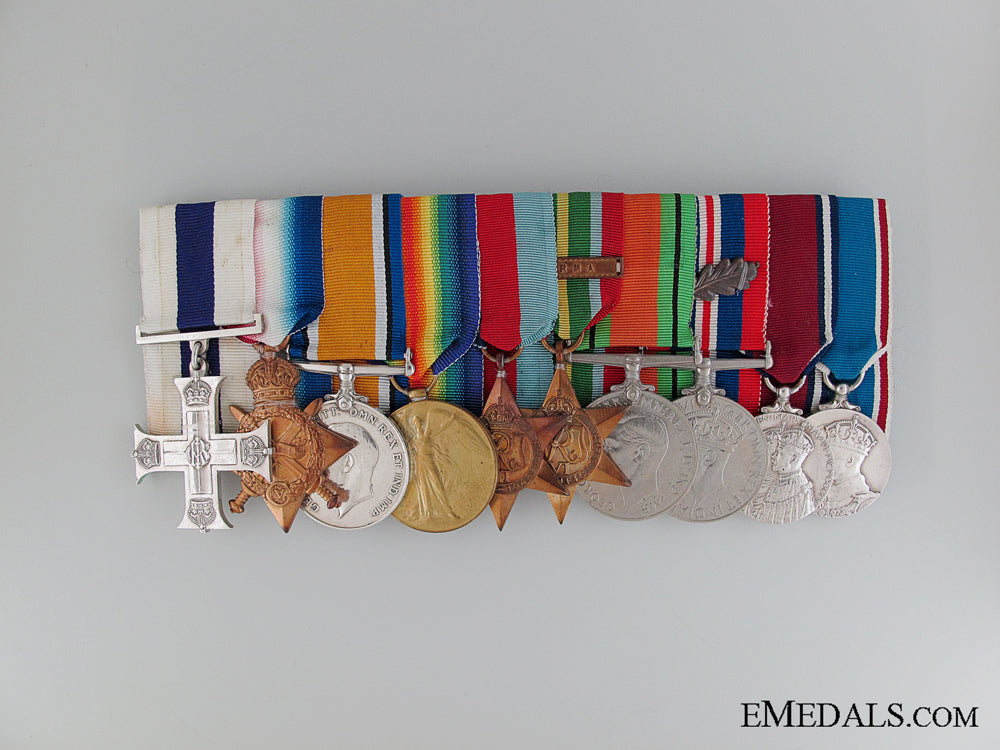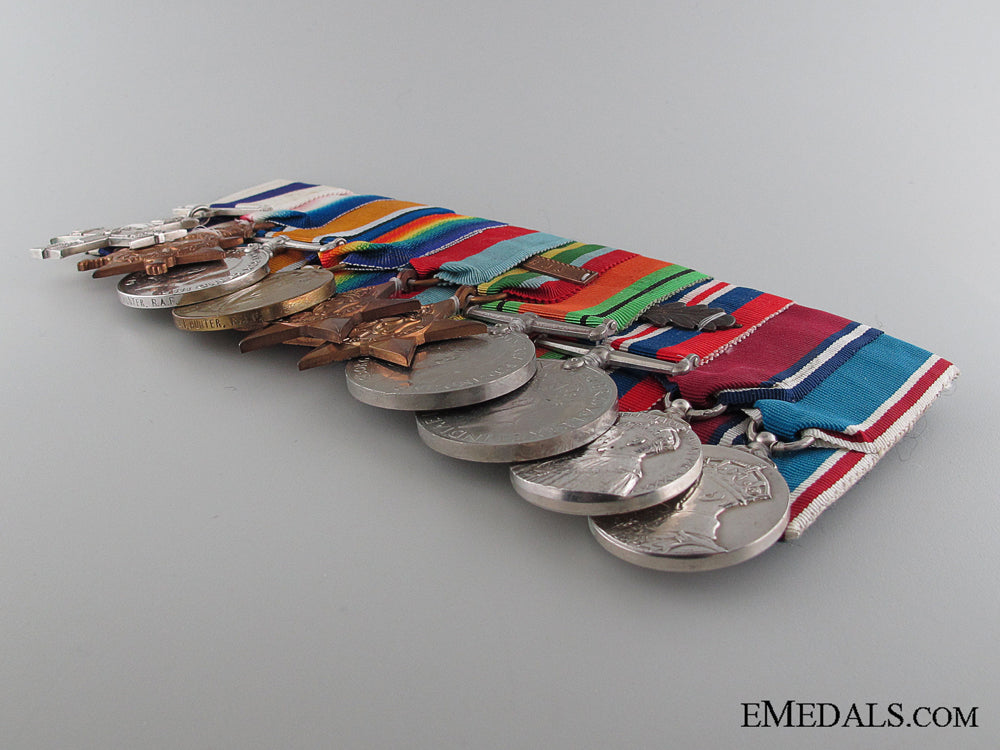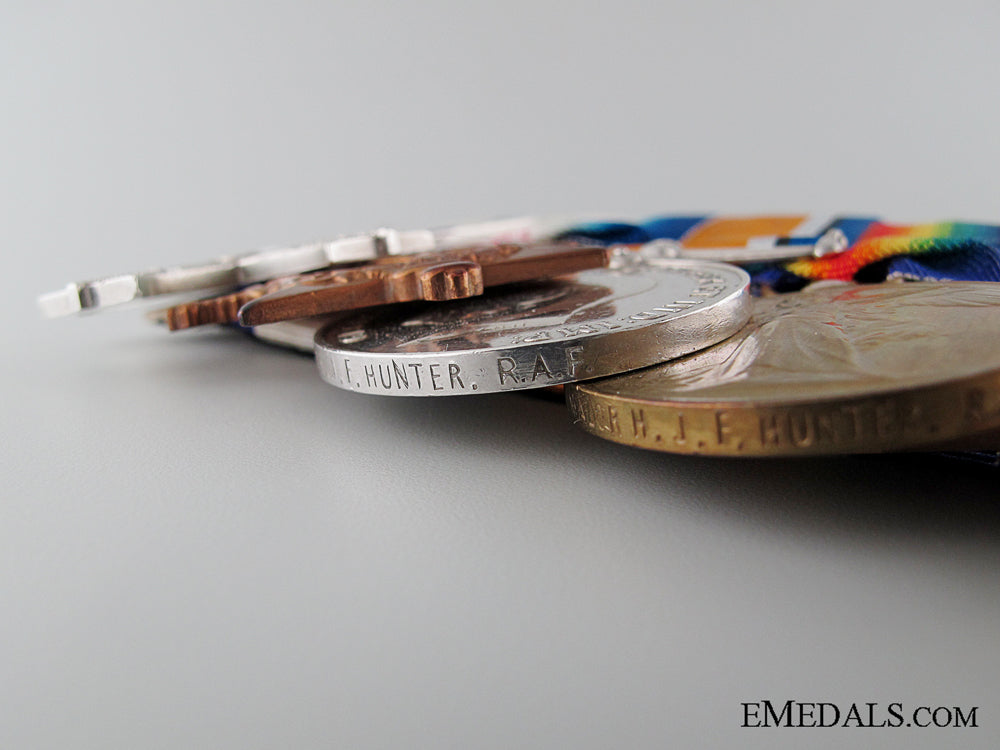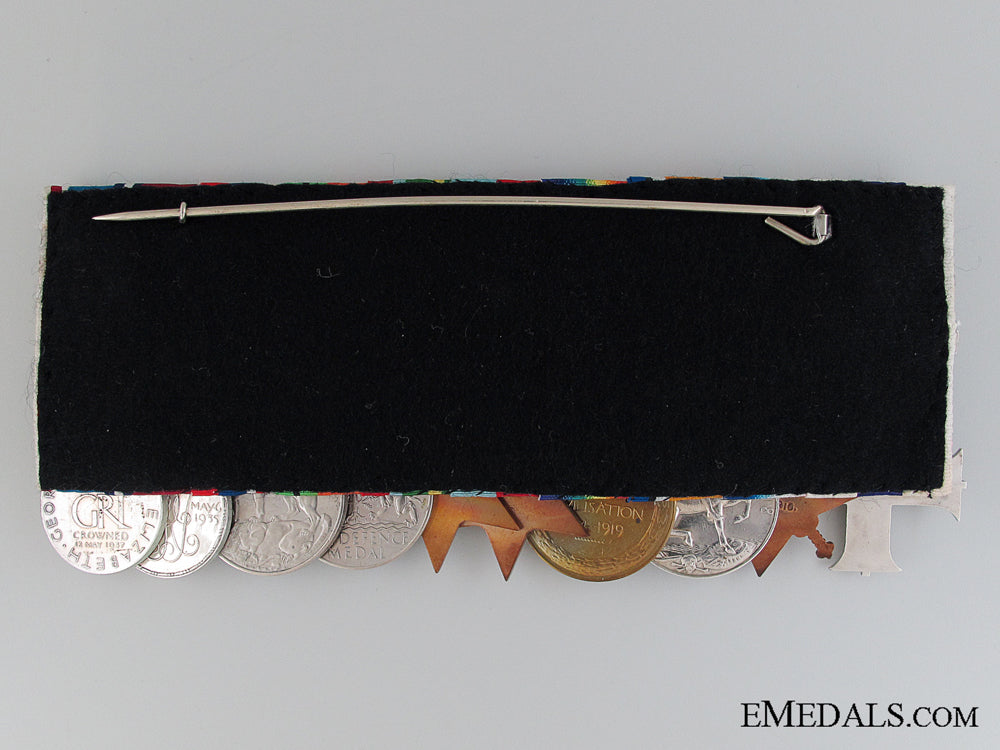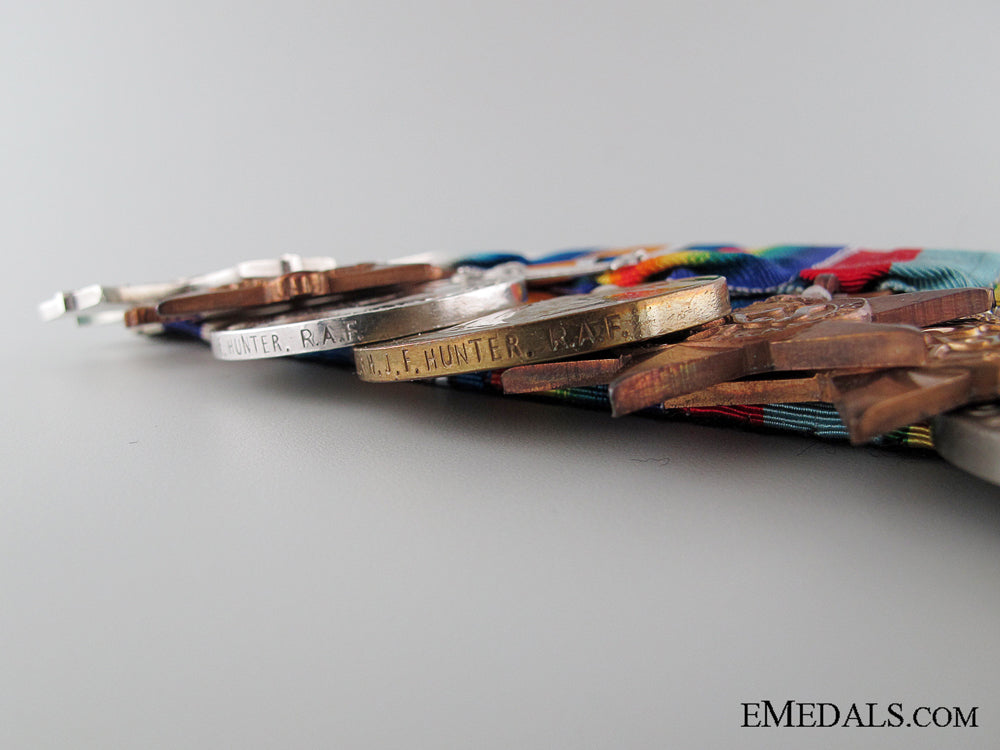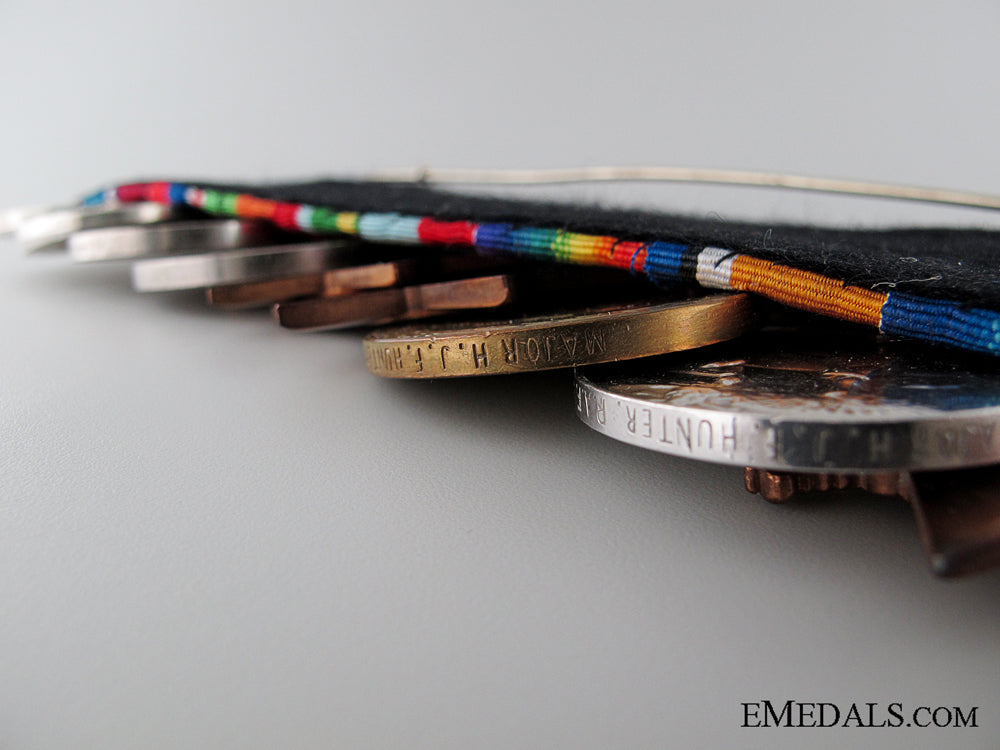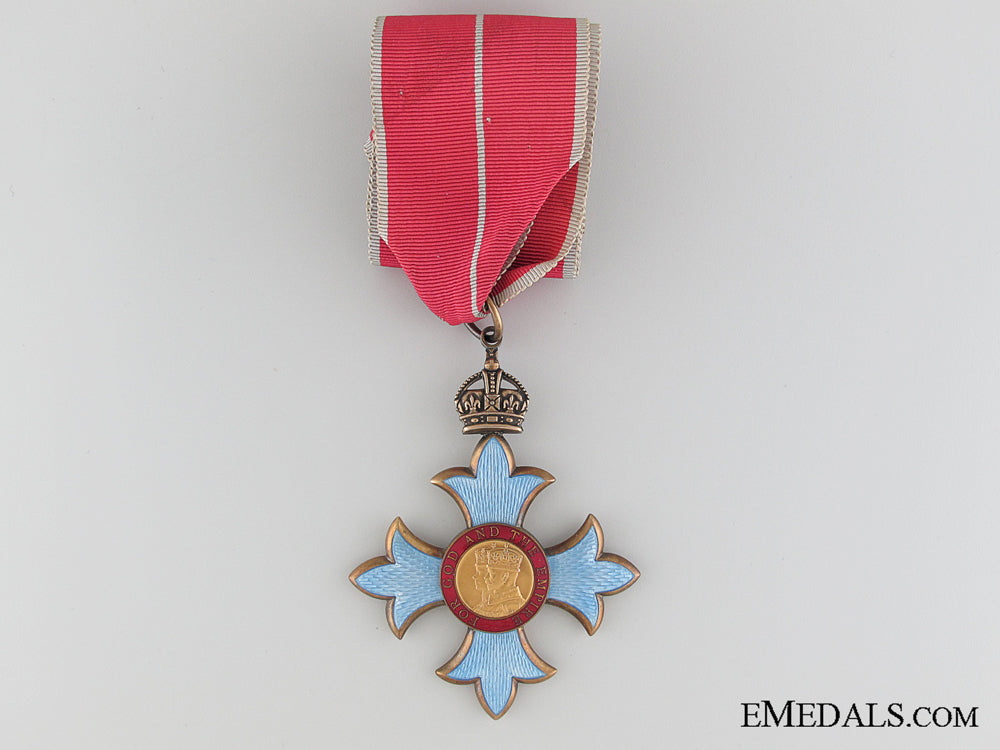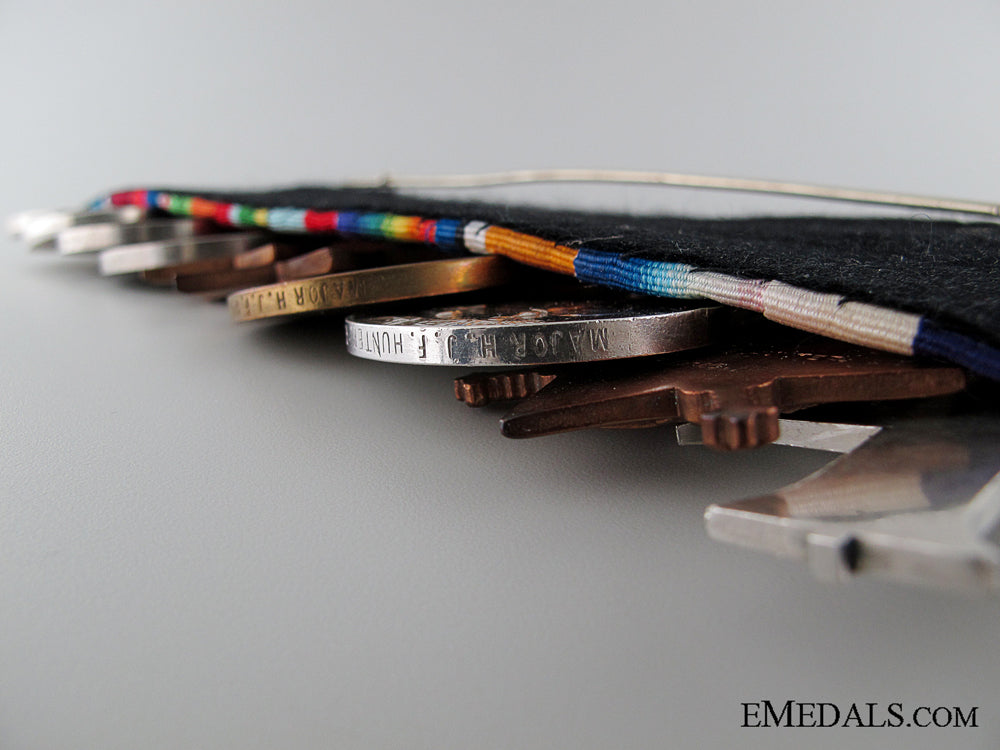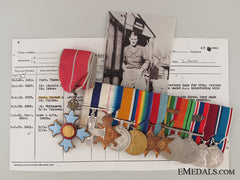Description
The Valourous Medal Bar of Air Commodore Hunter - Most Excellent Order of the British Empire, C.B.E. (Military) Commander, 2nd Type Neck Badge (silver gilt and enamels, on full-length neck ribbon); Military Cross, GRV; 1914-15 Star (LIEUT. H.J. HUNTER. RIF. BRIG.); British War Medal (MAJOR H.J.F. HUNTER. R.A.F.); Victory Medal (MAJOR H.J.F. HUNTER. R.A.F.); 1939-1945 Star; Pacific Star with BURMA Clasp; Defence Medal; War Medal 1939-1945 with MID oak leaf; Jubilee Medal 1935; and Coronation Medal 1937. Naming is officially impressed on the WWI medals. All but the CBE are court-mounted with swing bar pinback, as worn by the veteran, most with original ribbons, extremely fine. Accompanied by extensive paperwork enclosed in a binder, including copies of his WWI Service Records, Medical Records and Squadron Record Book entries, WWII Operations Record Book entries, Citations from the London Gazette and CBE Recommendation from the National Archives, along with a few reproduction photographs of Hunter.Footnote: Henry John Francis Hunter was a pilot and squadron commander in the Royal Flying Corps and later, a senior officer ion the Royal Air Force. He was born on December 29, 1893 in London, England, the son of Henry Charles Vicars Hunter and the Honourable Mrs. Florence L. Hunter (nee Dormer). He moved with his family to Shropshire shortly thereafter, was educated at Eton and the Royal Military College, Sandhurst, where he was Gentleman Cadet. Hunter was commissioned as a 2nd Lieutenant in the 1st Battalion, Rifle Brigade (The Prince Consort's Own) on February 5, 1913 and later entered service during the Great War, named as a Lieutenant on November 27, 1914. He was wounded in the legs by a bomb explosion in September 1915 in Poperinghe, Belgium while serving with the 1st Battalion, Rifle Brigade. Following his recovery, he successfully applied for pilot training in the Royal Flying Corps, seconded in Autumn 1915 by No. 34 Squadron, commanded by Major J.A. Charmier. He had always wanted to fly but not with the entire approval of his parents. Hunter was awarded his "Wings" after attending courses at Reading and Castle Bromwich in May 1916 and flew numerous missions over the Somme in 1916, flying B.2E's and R.E.8's, spotting for the Artillery, commanded No. 9 Squadron in the Ypres Salient in 1917 and No. 42 Squadron from the "German Spring Offensive" until the war's end. He was awarded an Royal Army Educational Corps Certificate, number 2872 on May 9, 1916. During his Royal Flying Corps service, he saw a number of appointments and advances in rank: to Captain (December 8, 1915), (T) Major (June 1, 1917), Flying Officer, No. 34 Squadron (May 24, 1916), Flight Commander (October 17, 1916), Officer Commanding, No. 9 Squadron (March 1917, operating over the Ypres Salient). Throughout his recollections, Hunter identified his chief menace as Anti-Aircraft fire (AKA "Archie"). The following excerpts indicate some of his RFC exploits and observations: "The unit's B.E.2e aircraft causing much mirth on arrival at St. Omer, on account of the number of suitcases and odd parcels tied to the under-carriage struts and also alongside the fuselages". A day or two later, No. 34 arrived at Lilbourne, and quickly commenced work as an artillery co-operation unit over the Somme, a period later described by Hunter in his Staff College submission: "I well remember one morning I was on the line at dawn and found some lorries behind the village of Martinpoich (Martinpuich, France). Very pleased with myself I was going down to drop my four 25lb. bombs, which were carried on all trips, when "Archie" with his first round broke most of my top plane extension and cut the aileron controls." In regards to machine gun fire: "I was very impressed withe the German M.G. and rifle fire. It seemed to be very well organised. Ammunition was rarely wasted if one was over 2,000 feet, but the moment one came down below that height, one was kept under continuous fire. M.G.'s seemed to be organised in batteries behind the lines and between then and the rifles our expenditure in wings and tail planes was heavy." In January 1917, the Squadron moved to Villers Bretonneux and worked on the front from Peronne southwards, this time in R.E.8s. It was here that Hunter recalled: "We soon had our first experience of looking for the enemy's troops in more or less open warfare. It did not take us long to discover the difficulties of locating troops in small numbers and of determining the general position of the enemy's front line. The method generally resorted to was to fly low and get fired at with rifles from a number of points, and then drop the information to our advanced cavalry and forward headquarters." In May 1917, Hunter was appointed to the command of No. 9 Squadron, in which capacity he participated in the Passchendaele offensive in support of XIV Corps. He documented the results: "Casualties were heavy in the Squadron, 135 officers going through in four months. Two aircraft were destroyed by direct hits from A.A. (Anti-Aircraft) on the first day we were on the sector. However, it spite of heavy casualties and hard work, the morale of the Squadron kept very high, and during my time in command, that is to November 1917, we got two D.S.Os, two Bars to the M.C., and 17 M.Cs, which speaks well for the general keenness and devotion to duty of the pilots. During the whole time I had been in France, I had been very much impressed with the necessity of watching pilots very carefully and if at all possible of sending them on leave as soon as they showed signs of strain. Working with an army co-operation squadron on a battle front, it was a rare occurrence to find a pilot fit for more than three months continuous work. Fourteen days leave, given in time, invariably put a man right again." Returning to the United Kingdom for duties as an instructor in November 1917, as a result of "stress of service", Hunter was posted back to France, to take command of No. 42 Squadron in April 1918. The unit "was in a very bad state having got into trouble in Italy.....most of them were drinking far too much.....it required constant supervision from the air and from battery positions." In addition, the moving front caused by the German Spring Offensive made the task of locating targets difficult in the extreme but the tide of war changed, with Hunter's leadership from the front resulting in some notable successes: "For the last few days before the Armistice we got a lot more ground strafing as now the enemy were retiring in great confusion. On 9 November, I remember finding a column on a straight road composed of four gun teams, about a battalion of infantry and what I thought was a lorry. By flying up and down the road we managed to inflict a large number of casualties. What I thought was a lorry turned out to be an A.A. (Anti-Aircraft) gun but it was of course practically useless at our height. Just after the Armistice, I examined several positions again against which I carried out shoots. As guns had been in the open it was difficult in most places to verify damage but in one position in particular, in the wooded grounds of a convent, I was very much interested. The C.B. office had given it as two big howitzers, 8-inch I think, and I had had what I thought was a pretty successful shoot. In the grounds of the convent I found an old priest and asked him if he remembered a rather heavy bombardment on a certain day. He was delighted and told me that both guns had been destroyed, all the horses killed, as well as 16 Germans and two nuns. On my expressing due sympathy over the nuns, he told me that they were very old and it didn't matter a bit!" Hunter was awarded his Military Cross as a pilot, as cited in the London Gazette on October 20, 1916: "For conspicuous gallantry and skill. He has done fine work for the artillery and has accounted for many enemy guns. On one occasion, when a heavy storm drove all other machines back to their aerodromes and the enemy guns took the opportunity to become active, he remained up and did fine work." He was Mentioned in Despatches twice: London Gazette on December 11, 1917: "As a Corps Squadron Commander from the beginning of June 1917 till this date, Major Hunter has done fine work, keeping his squadron most efficient and maintaining a very high morale and standard of work.", and also on July 11, 1919 for same. His brother, Captain Thomas Vicars Hunter, 66th Squadron, Royal Flying Corps, also late of the Rifle Brigade, was also in the war and was Killed in Action on December 5, 1917 in Italy, at the age of 20. He is buried Carmignano di Brenta Communal Cemetery (between Vicenza and Treviso) Italy. Hunter joined the Royal Air Force in April 1918, when the Royal Flying Corps merged with the Royal Naval Air Service. Before the termination of the war, he married the Honourable Mrs. Pearson, widow of the Honourable Geoffery Pearson on April 11, 1918, while Officer Commanding, No. 42 Squadron (RE8) (as of April 17, 1918, until the end of the war). Between the wars, the appointments and transfers continued to mount: he was named Officer Commanding, No. 105 Squadron (Bristol F2B) in Ireland (January 15, 1919), Officer Commanding, School of Army (Artillery) Co-operation (July 25, 1919), awarded permanent commission as a Major (London Gazette on August 22, 1919), Officer Commanding, No. 12 Squadron (Bristol F2B) Army of Occupation in Cologne, Germany (March 1, 1921), Supernumerary, Royal Air Force Depot (May 25, 1922), Personnel Staff, Headquarters No. 10 Group (September 19, 1922), followed by seven years in the Fleet Air Arm (which took him to China in an aircraft carrier), Staff, RAF Training Base, Leuchars (November 8, 1925), Wing Commander (January 1, 1926), attended Royal Navy War College (March 14, 1927), Officer Commander Flying, HMS Hermes (January 2, 1928), Supernumerary, RAF Depot (November 10, 1928), attended RAF Staff College (January 21, 1929), Officer Commanding, No. 1 (Apprentices) Wing, No. 1 School of Technical Training (Apprentices) at Halton (December 14, 1929, until 1932), named Group Captain (January 1, 1933, Senior Air Staff Officer, Fighting Area Headquarters (February 6, 1933, in charge of training), transferred to Iraq as Officer Commanding, Aircraft Depot (October 10, 1934 to 1935), returning to the United Kingdom as Officer Commanding, RAF Finningley (January 18, 1937, until June 1939). He also married Kathleen Witts in 1935, having one son and one daughter with her. After twenty-six years combined military service, he retired from the Royal Air Force at his own request on June 15, 1939. Upon the outbreak of hostilities, Hunter was recalled to service on September 26, 1939. He served two years in Bomber Command (night bombers) at Driffield and formed a solid relationship with Air Vice-Marshall Coningham, the Allied Air Commander in the Field in North Africa. He commanded RAF Station, Topcliffe (beginning in 1940 to January 1942) before going to the Far East, arriving in Sumatra just after the Royal Air Force evacuation of Singapore and was placed in command of Bomber Squadrons in Sumatra and Java. Now with No. 225 (Bomber) Group as Acting Air Commodore (January 30, 1942), and later retained as Air Commodore (April 20, 1942), Hunter was given the task of forming a bomber group (No. 225) from the remnants of the RAF in the area. Operating from a secret airfield near Palembang (P2) (in South Sumatra province of modern day Indonesia), he attempted to stem the Japanese advance as best he could. At one point, he received news that the other airfield in the area was near to capture. He subsequently ordered P2 to be evacuated and destroyed, only to later find out that the Japanese still did not know pf P2's existence. He immediately ordered the evacuation to stop but by then serious damage had been inflicted upon P2. He later commanded Indian and RAF Bomber Squadrons, Burma Battlefront, responsible for the fighter defence of Calcutta as an Air Commodore, No. 223 (Fighter) Group (May 1, 1943) and is also documented as served in Ceylon (Sri Lanka) in 1944. Hunter was conferred the Honour of Knighthood (Supplement to The London Gazette, page 2453, Friday, May 28, 1943) and was twice Mentioned in Despatches (June 2, 1943 and January 11, 1944). Hunter was noted as a Commanding Officer who led from the front. Although he was unable to turn the tide of war as Air Officer Commanding (Bombers) in the face of the Japanese invasion of Sumatra in February 1942, he was awarded the CBE for his courage under attack as a Station Commanding Officer in the United Kingdom at RAF Driffield. His CBE recommendation appeared in the London Gazette on September 24, 1941: "This officer has commanded an operational station with two heavy bomber squadrons since September 1939, when he took over command of the R.A.F. Station, Driffield. After severe bombing and successive attacks which necessitated the transfer of the two squadrons, he opened up R.A.F. Topcliffe and has continued operations under most difficult conditions. He has shown unfailing loyalty, keenness and devotion to duty and does not spare himself in directing, guiding and encouraging his crews. The fact that the station and squadrons are full of fight is due a great deal to the example of steady courage and calm control of Group Captain Hunter during bombing attacks, one of which was more severe than on any other station in England." He reverted to the Retired List on January 18, 1946, later marrying Kathleen Kirkpatrick, daughter of Mr. Justice Morice, in 1949 and lived in Little Warham, Bedford, North Devon. Throughout his life, Hunter was known as a top flight athlete and for many years, he held the RAF singles and doubles tennis championships, having also played at Wimbledon, in addition to being a good golfer. He believed that "physical fitness brings mental fitness". In his retirement years, he painted landscapes in oils as a relaxation tool. Hunter died on September 12, 1966, at the age of 72.

